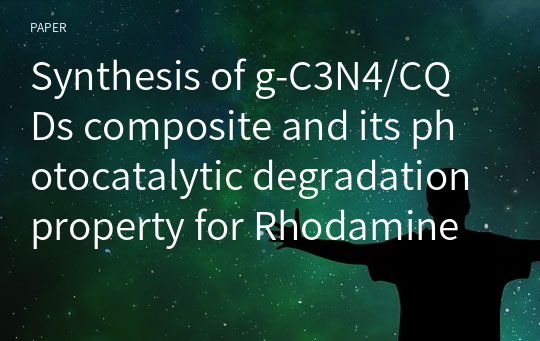Synthesis of g‑C3N4/CQDs composite and its photocatalytic degradation property for Rhodamine B
* 본 문서는 배포용으로 복사 및 편집이 불가합니다.
서지정보
ㆍ발행기관 : 한국탄소학회
ㆍ수록지정보 : Carbon letters / 32권 / 6호
ㆍ저자명 : Tao Jin, Chengbao Liu, Feng Chen, Junchao Qian, Yongbin Qiu, Xianrong Meng, Zhigang Chen
ㆍ저자명 : Tao Jin, Chengbao Liu, Feng Chen, Junchao Qian, Yongbin Qiu, Xianrong Meng, Zhigang Chen
목차
AbstractGraphical abstract
1 Introduction
2 Experimental section
2.1 Chemicals and reagents
2.2 Preparation of g-C3N4
2.3 Preparation of CQDs precursors
2.4 Preparation of g-C3N4CQDs
2.5 Characterization
2.6 Photocatalytic degradation
3 Results and discussion
3.1 Characterization of photocatalysts
3.2 Photocatalytic activities
4 Conclusion
Acknowledgements
References
영어 초록
To solve the problem of water pollution, researchers have proposed a photocatalytic degradation technology, in which the key factor is the development of efficient photocatalytic materials. Graphitic carbon nitride (g-C3N4), an n-type semiconductor, has been widely studied due to its suitable band gap (2.7 eV), low cost, easy preparation, non-toxicity, and high photostability. However, the pure-phase g-C3N4 still has defects such as low specific surface area, insufficient visible light absorption, low charge mobility, few active sites for interfacial reaction, and easy recombination of photogenerated electron–hole pairs, which leads to the lower photocatalytic activity of g-C3N4. Aiming at the problems mentioned above, this paper focus on the synthesis of g-C3N4-based composites with high photocatalytic activity via lemon juice induction method. Thiourea and lemon juice were selected as precursors, and carbon quantum dots (CQDs) as electron mediators were introduced anchoring on the surface of g-C3N4 to build g-C3N4/CQDs with compact interface. The results showed that small-sized CQDs are uniformly distributed on the surface of g-C3N4, and the g-C3N4/CQDs composite has a 2D0D structure, which reduces the recombination of photogenerated electron–hole pairs. The photocatalytic degradation efficiency of 4% g-C3N4/CQDs for RhB reaches the highest data of 90.9%, and the photocatalytic degradation rate is 0.016 min− 1, which is about 2.3 times that of g-C3N4. After four cycles of photocatalytic reaction, the photocatalytic degradation efficiency of the material remained at 81.7%. Therefore, the g-C3N4/CQDs synthesized via lemon juice induction has a more stable microstructure, and the charge separation efficiency is greatly improved, which is suitable for practical photocatalytic environmental protection.참고 자료
없음태그
"Carbon letters"의 다른 논문
 Efficient hydrogen generation from the NaBH4 methanolys..9페이지
Efficient hydrogen generation from the NaBH4 methanolys..9페이지 Copper nanoparticles supported on biocarbon film from S..16페이지
Copper nanoparticles supported on biocarbon film from S..16페이지 Optical properties of reduced graphene oxide nanodots p..10페이지
Optical properties of reduced graphene oxide nanodots p..10페이지 Influence of graphite platelets with and without SiC on..8페이지
Influence of graphite platelets with and without SiC on..8페이지 Waste plastic‑derived FWCNT‑NiMgAl composite for superc..17페이지
Waste plastic‑derived FWCNT‑NiMgAl composite for superc..17페이지 Enhanced electrosorption of NaCl and nickel(II) in capa..10페이지
Enhanced electrosorption of NaCl and nickel(II) in capa..10페이지 Facile diazonium modification of pomegranate peel bioch..11페이지
Facile diazonium modification of pomegranate peel bioch..11페이지 Effect of anion species on preparation and properties o..12페이지
Effect of anion species on preparation and properties o..12페이지 Electrochemical performance of various activated carbon..25페이지
Electrochemical performance of various activated carbon..25페이지 Preparation of environmental‑friendly N‑rich chitin‑der..7페이지
Preparation of environmental‑friendly N‑rich chitin‑der..7페이지


























